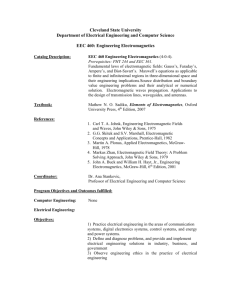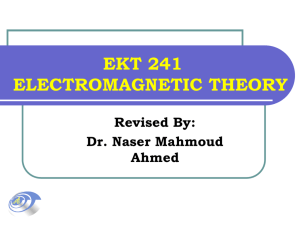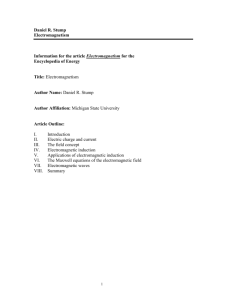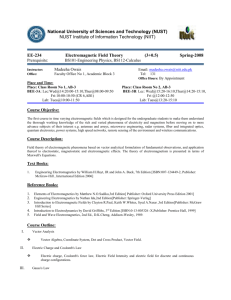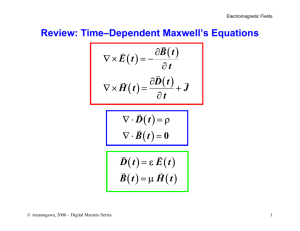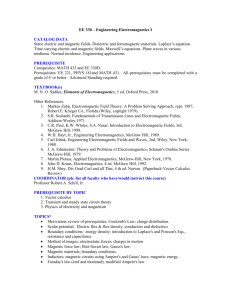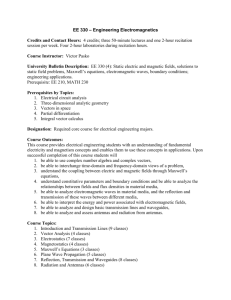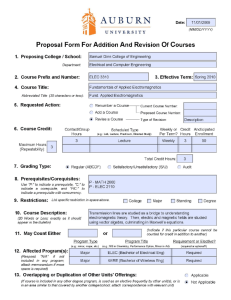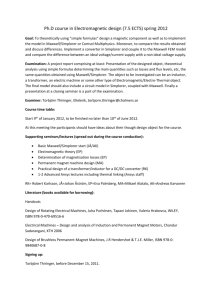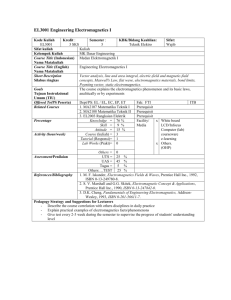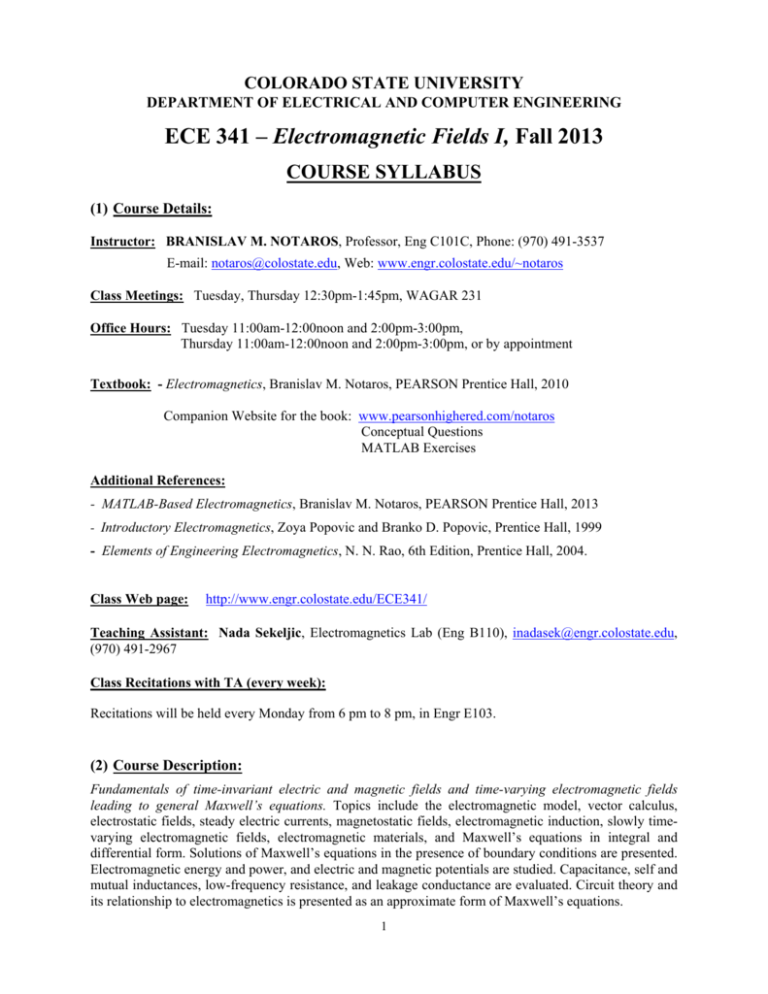
COLORADO STATE UNIVERSITY
DEPARTMENT OF ELECTRICAL AND COMPUTER ENGINEERING
ECE 341 – Electromagnetic Fields I, Fall 2013
COURSE SYLLABUS
(1) Course Details:
Instructor: BRANISLAV M. NOTAROS, Professor, Eng C101C, Phone: (970) 491-3537
E-mail: notaros@colostate.edu, Web: www.engr.colostate.edu/~notaros
Class Meetings: Tuesday, Thursday 12:30pm-1:45pm, WAGAR 231
Office Hours: Tuesday 11:00am-12:00noon and 2:00pm-3:00pm,
Thursday 11:00am-12:00noon and 2:00pm-3:00pm, or by appointment
Textbook: - Electromagnetics, Branislav M. Notaros, PEARSON Prentice Hall, 2010
Companion Website for the book: www.pearsonhighered.com/notaros
Conceptual Questions
MATLAB Exercises
Additional References:
- MATLAB-Based Electromagnetics, Branislav M. Notaros, PEARSON Prentice Hall, 2013
- Introductory Electromagnetics, Zoya Popovic and Branko D. Popovic, Prentice Hall, 1999
- Elements of Engineering Electromagnetics, N. N. Rao, 6th Edition, Prentice Hall, 2004.
Class Web page:
http://www.engr.colostate.edu/ECE341/
Teaching Assistant: Nada Sekeljic, Electromagnetics Lab (Eng B110), inadasek@engr.colostate.edu,
(970) 491-2967
Class Recitations with TA (every week):
Recitations will be held every Monday from 6 pm to 8 pm, in Engr E103.
(2) Course Description:
Fundamentals of time-invariant electric and magnetic fields and time-varying electromagnetic fields
leading to general Maxwell’s equations. Topics include the electromagnetic model, vector calculus,
electrostatic fields, steady electric currents, magnetostatic fields, electromagnetic induction, slowly timevarying electromagnetic fields, electromagnetic materials, and Maxwell’s equations in integral and
differential form. Solutions of Maxwell’s equations in the presence of boundary conditions are presented.
Electromagnetic energy and power, and electric and magnetic potentials are studied. Capacitance, self and
mutual inductances, low-frequency resistance, and leakage conductance are evaluated. Circuit theory and
its relationship to electromagnetics is presented as an approximate form of Maxwell’s equations.
1
(3) Organization of Course Topics:
1.
2.
3.
4.
5.
6.
7.
Electrostatic field in free space (Chapter 1)
Dielectrics, capacitance, and electric energy (Chapter 2)
Steady electric currents (Chapter 3)
Magnetostatic field in free space (Chapter 4)
Magnetostatic field in material media (Chapter 5)
Slowly time-varying electromagnetic field (Chapter 6)
Inductance and magnetic energy (Chapter 7)
No.of Weeks (tentative)
3
3
2
2
2
2
1
(4) Homework:
Homework will be assigned weekly. Homework assignments will be posted on the T drive, in
T:\classes\ECE\ECE341. The file names will be self-explanatory (for example, ECE341_Fall2013_
HW1_assignment.PDF for Homework 1). The assignment will also be sent by email.
Homework will be due at the specified time the following week in the ECE341 drop box. Late
homework is not allowed and will not be collected.
The solutions to homework problems will be posted on the T drive, in T:\classes\ECE\ECE341 (for
example, ECE341_Fall2013_HW1_solutions.PDF for solutions to Homework 1).
Graded homework can be seen and picked up from the TA during recitations.
(5) Evaluation of Students and Grading Policy:
Homework (20%)
Exam 1 (25%)
Exam 2 (25%)
Final Exam (30%)
Grades will be assigned from A+ through F, including plus and minus categories (no C-, D+, and D-),
according to the following grading rubric:
97 ≤ x ≤ 100 A+; 93 ≤ x < 97 A; 90 ≤ x < 93 A-; 87 ≤ x < 90 B+; 83 ≤ x < 87 B; 80 ≤ x < 83 B-; 77 ≤
x < 80 C+; 70 ≤ x < 77 C; 60 ≤ x < 70 D; x < 60 F;
(6) Exams:
Exam 1 – Thursday, October 10, 2013, in class
Exam 2 – Thursday, December 5, 2013, in class
Final Exam – see the Fall 2012 Final Exam Schedule on the CSU web
All exams are closed book, closed notes. No calculators are allowed. One sheet with hand-written
formulas prepared by the student is allowed per each partial exam, and two sheets for the final exam.
2
(7) Academic Integrity Policy:
-
This course will adhere to the CSU Academic Integrity Policy as found in the General Catalog
(http://www.catalog.colostate.edu/FrontPDF/1.6POLICIES1112f.pdf) and the Student Conduct Code
(http://www.conflictresolution.colostate.edu/conduct-code). At a minimum, violations will result in a
grading penalty in this course and a report to the Office of Conflict Resolution and Student Conduct
Services.
(8) Course Objectives/Outcomes:
Please also see the ECE341 IO Diagram (attached)
The objectives of the course are for the students to develop an understanding of electromagnetic-field
fundamentals by emphasizing both mathematical analytical rigor and physical conceptual reasoning, as
applied toward practical engineering problems. Students learn to analyze engineering systems based on
electrostatic fields, steady electric currents, and magnetostatic fields in arbitrary material media, and to
apply vector calculus to solve a large variety of static field problems. Students develop a solid grasp and
true appreciation of Maxwell’s equations and use these equations to solve slowly time-varying field
problems. By the end of this course, students should be able to:
1. Appreciate fields.
2. Solve realistic electromagnetic-field problems utilizing physical conceptual reasoning and
mathematical synthesis of solutions, and not pure formulaic solving.
3. Understand electric and magnetic properties of material media and how these properties can be
exploited in engineering applications.
4. Visualize electric and magnetic fields and understand associated abstract field phenomena.
5. Utilize three-dimensional vector differential and integral concepts to solve real-life electromagneticfield problems.
6. Understand fundamentals of energy and power, and electric and magnetic potentials.
7. Appreciate fundamental laws and work of pioneering giants of electromagnetics, their historical
perspective in the development of science and engineering and current relevance in cutting-edge
engineering applications.
8. Mathematically model electromagnetic-field physical structures and processes.
9. Geometrically represent and spatially visualize realistic three-dimensional devices and systems.
10. Appreciate electromagnetic field theory as a foundation of circuit theory and electrical engineering as
a whole.
11. Understand limitations of circuit theory as an approximation of field theory.
3

